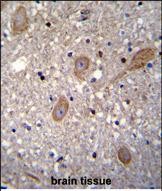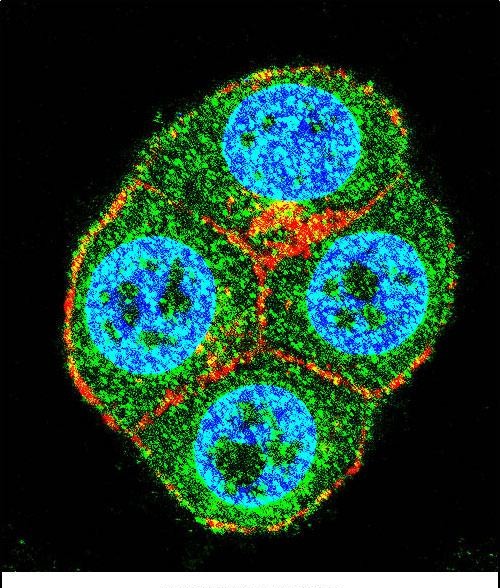BTRC Antibody (N-term)
Affinity Purified Rabbit Polyclonal Antibody (Pab)
- 产品详情
- 文献引用 : 1
- 实验流程
- 背景知识
Application
| WB, IHC-P, IF, E |
|---|---|
| Primary Accession | Q9Y297 |
| Other Accession | Q3ULA2, NP_378663 |
| Reactivity | Human, Mouse |
| Predicted | Mouse |
| Host | Rabbit |
| Clonality | Polyclonal |
| Isotype | Rabbit IgG |
| Calculated MW | 68867 Da |
| Antigen Region | 17-52 aa |
| Gene ID | 8945 |
|---|---|
| Other Names | F-box/WD repeat-containing protein 1A, E3RSIkappaB, Epididymis tissue protein Li 2a, F-box and WD repeats protein beta-TrCP, pIkappaBalpha-E3 receptor subunit, BTRC, BTRCP, FBW1A, FBXW1A |
| Target/Specificity | This BTRC antibody is generated from rabbits immunized with a KLH conjugated synthetic peptide between 17-52 amino acids from the N-terminal region of human BTRC. |
| Dilution | WB~~1:1000 IHC-P~~1:100~500 IF~~1:10~50 E~~Use at an assay dependent concentration. |
| Format | Purified polyclonal antibody supplied in PBS with 0.09% (W/V) sodium azide. This antibody is purified through a protein A column, followed by peptide affinity purification. |
| Storage | Maintain refrigerated at 2-8°C for up to 2 weeks. For long term storage store at -20°C in small aliquots to prevent freeze-thaw cycles. |
| Precautions | BTRC Antibody (N-term) is for research use only and not for use in diagnostic or therapeutic procedures. |
| Name | BTRC |
|---|---|
| Synonyms | BTRCP, FBW1A, FBXW1A |
| Function | Substrate recognition component of a SCF (SKP1-CUL1-F-box protein) E3 ubiquitin-protein ligase complex which mediates the ubiquitination and subsequent proteasomal degradation of target proteins (PubMed:10066435, PubMed:10497169, PubMed:10644755, PubMed:10835356, PubMed:11158290, PubMed:11238952, PubMed:11359933, PubMed:11994270, PubMed:12791267, PubMed:12902344, PubMed:14603323, PubMed:14681206, PubMed:14988407, PubMed:15448698, PubMed:15917222, PubMed:16371461, PubMed:22017875, PubMed:22017876, PubMed:22017877, PubMed:22087322, PubMed:25503564, PubMed:25704143, PubMed:36608670, PubMed:9859996, PubMed:9990852). Recognizes and binds to phosphorylated target proteins (PubMed:10066435, PubMed:10497169, PubMed:10644755, PubMed:10835356, PubMed:11158290, PubMed:11238952, PubMed:11359933, PubMed:11994270, PubMed:12791267, PubMed:12902344, PubMed:14603323, PubMed:14681206, PubMed:14988407, PubMed:15448698, PubMed:15917222, PubMed:16371461, PubMed:22017875, PubMed:22017876, PubMed:22017877, PubMed:22087322, PubMed:25503564, PubMed:25704143, PubMed:36608670, PubMed:9859996, PubMed:9990852). SCF(BTRC) mediates the ubiquitination of CTNNB1 and participates in Wnt signaling (PubMed:12077367, PubMed:12820959). SCF(BTRC) mediates the ubiquitination of phosphorylated NFKB1, ATF4, CDC25A, DLG1, FBXO5, PER1, SMAD3, SMAD4, SNAI1 and probably NFKB2 (PubMed:10835356, PubMed:11238952, PubMed:14603323, PubMed:14681206). SCF(BTRC) mediates the ubiquitination of NFKBIA, NFKBIB and NFKBIE; the degradation frees the associated NFKB1 to translocate into the nucleus and to activate transcription (PubMed:10066435, PubMed:10497169, PubMed:10644755, PubMed:9859996). Ubiquitination of NFKBIA occurs at 'Lys-21' and 'Lys- 22' (PubMed:10066435). The SCF(FBXW11) complex also regulates NF-kappa- B by mediating ubiquitination of phosphorylated NFKB1: specifically ubiquitinates the p105 form of NFKB1, leading to its degradation (PubMed:10835356, PubMed:11158290, PubMed:14673179). SCF(BTRC) mediates the ubiquitination of CEP68; this is required for centriole separation during mitosis (PubMed:25503564, PubMed:25704143). SCF(BTRC) mediates the ubiquitination and subsequent degradation of nuclear NFE2L1 (By similarity). Has an essential role in the control of the clock- dependent transcription via degradation of phosphorylated PER1 and PER2 (PubMed:15917222). May be involved in ubiquitination and subsequent proteasomal degradation through a DBB1-CUL4 E3 ubiquitin-protein ligase. Required for activation of NFKB-mediated transcription by IL1B, MAP3K14, MAP3K1, IKBKB and TNF. Required for proteolytic processing of GLI3 (PubMed:16371461). Mediates ubiquitination of REST, thereby leading to its proteasomal degradation (PubMed:18354482, PubMed:21258371). SCF(BTRC) mediates the ubiquitination and subsequent proteasomal degradation of KLF4; thereby negatively regulating cell pluripotency maintenance and embryogenesis (By similarity). SCF(BTRC) acts as a regulator of mTORC1 signaling pathway by catalyzing ubiquitination and subsequent proteasomal degradation of phosphorylated DEPTOR, TFE3 and MITF (PubMed:22017875, PubMed:22017876, PubMed:22017877, PubMed:33110214, PubMed:36608670). SCF(BTRC) directs 'Lys-48'-linked ubiquitination of UBR2 in the T-cell receptor signaling pathway (PubMed:38225265). |
| Cellular Location | Cytoplasm {ECO:0000250|UniProtKB:Q3ULA2}. Nucleus {ECO:0000250|UniProtKB:Q3ULA2} |
| Tissue Location | Expressed in epididymis (at protein level). |
For Research Use Only. Not For Use In Diagnostic Procedures.

Provided below are standard protocols that you may find useful for product applications.
BACKGROUND
This gene encodes a member of the F-box protein family which is characterized by an approximately 40 amino acid motif, the F-box. The F-box proteins constitute one of the four subunits of ubiquitin protein ligase complex called SCFs (SKP1-cullin-F-box), which function in phosphorylation-dependent ubiquitination. The F-box proteins are divided into 3 classes: Fbws containing WD-40 domains, Fbls containing leucine-rich repeats, and Fbxs containing either different protein-protein interaction modules or no recognizable motifs. The protein encoded by this gene belongs to the Fbws class; in addition to an F-box, this protein contains multiple WD-40 repeats. This protein is homologous to Xenopus bTrCP1, yeast Met30, Neurospora Scon2 and Drosophila Slimb proteins. It interacts with HIV-1 Vpu and connects CD4 to the proteolytic machinery. It also associates specifically with phosphorylated IkappaBalpha and beta-catenin destruction motifs, probably functioning in multiple transcriptional programs by activating the NF-kappaB pathway and inhibiting the beta-catenin pathway.
REFERENCES
Popov, N., et al. Nat. Cell Biol. 12(10):973-981(2010) Inuzuka, H., et al. Cancer Cell 18(2):147-159(2010) Guderian, G., et al. J. Cell. Sci. 123 (PT 13), 2163-2169 (2010) : Rose, J.E., et al. Mol. Med. 16 (7-8), 247-253 (2010) : Tsai, W.B., et al. PLoS ONE 5 (7), E11171 (2010) :
终于等到您。ABCEPTA(百远生物)抗体产品。
点击下方“我要评价 ”按钮提交您的反馈信息,您的反馈和评价是我们最宝贵的财富之一,
我们将在1-3个工作日内处理您的反馈信息。
如有疑问,联系:0512-88856768 tech-china@abcepta.com.






















 癌症的基本特征包括细胞增殖、血管生成、迁移、凋亡逃避机制和细胞永生等。找到癌症发生过程中这些通路的关键标记物和对应的抗体用于检测至关重要。
癌症的基本特征包括细胞增殖、血管生成、迁移、凋亡逃避机制和细胞永生等。找到癌症发生过程中这些通路的关键标记物和对应的抗体用于检测至关重要。 为您推荐一个泛素化位点预测神器——泛素化分析工具,可以为您的蛋白的泛素化位点作出预测和评分。
为您推荐一个泛素化位点预测神器——泛素化分析工具,可以为您的蛋白的泛素化位点作出预测和评分。 细胞自噬受体图形绘图工具为你的蛋白的细胞受体结合位点作出预测和评分,识别结合到自噬通路中的蛋白是非常重要的,便于让我们理解自噬在正常生理、病理过程中的作用,如发育、细胞分化、神经退化性疾病、压力条件下、感染和癌症。
细胞自噬受体图形绘图工具为你的蛋白的细胞受体结合位点作出预测和评分,识别结合到自噬通路中的蛋白是非常重要的,便于让我们理解自噬在正常生理、病理过程中的作用,如发育、细胞分化、神经退化性疾病、压力条件下、感染和癌症。








